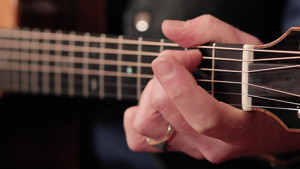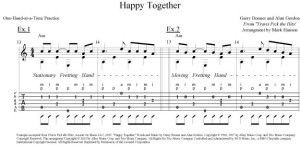April, 2016
The following is a practice technique I have used for years with my students: practice one hand at a time.
In my experience, as fingerstyle students learn a new tune, they often struggle moving the fretting-hand in time with the picking hand. Most often the rhythm suffers – the student slows down (or stops…) in order to include all of the notes. Consider taking a hint from the piano world: train your hands one at a time.
The Notation/Tab seen above is taken from “Happy Together” from my recent book/CD Travis Pick the Hits! (See and hear the entire passage here.) Ex.1 requires no fretting-hand movement (only a stationary A-minor chord) so you are practicing ONLY the picking hand. Do this over and over – slowly at first – until the picking hand is comfortable.
You’ll notice that the melody is not exactly as it should be. Don’t worry about that. It will arrive momentarily.
Next, practice the notated fretting-hand movements in Ex.2, without the picking hand. In this example, the index and little fingers move while the middle and ring remain stationary.
Now that each hand has some built-in muscle memory, you are ready to combine the two hands. Play Ex.2 at a slow enough speed so you can play it with the correct rhythm. In other words: practice playing it CORRECTLY! This passage corresponds to Ms.13-14 in the book, matching the Verse 2 lyric “call you up, invest a dime…”
The one caveat of the one-hand-at-a-time approach on the guitar: if the melody includes notes other than the ones in the fretted chord, the melody won’t sound exactly as it should (Ex.1). But, you will have the rhythm and and picking pattern under control, and have a head start on the fretting-hand requirements.
Try this method with your own music, without rewriting the notation or Tab. Think of it this way: play the music you are reading, just don’t move the fretting hand from the stationary chord. If you need to write out the tablature or notation as it would sound with no fretting-hand movement, by all means do so.
You may find that this can be an effective method for learning a challenging passage in a new tune!



